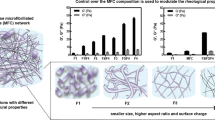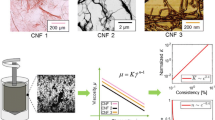Abstract
The concept of crowding factor applied to the flocculation of cellulose fibres is revisited through the application of percolation and effective medium theories. It is shown that, even if the crowding factor allows predicting the critical concentration of fibre suspension above which flocculation occurs, and indeed leads to acceptable results in most cases, percolation and effective medium theories are most rigorous and much less empirical. Examples of calculation are given for fibres assumed to behave either like rigid rods or like elongated prolate ellipsoids, and compare very correctly with experimental measurements found in the literature. Finally, beyond the purely geometrical aspects, the roles of several physico-chemical parameters on the onset of flocculation are also discussed, and shown to be perfectly explained by percolation predictions.






Similar content being viewed by others
References
Alon U, Balberg I, Drory A (1991) New, heuristic, percolation criterion for continuum systems. Phys Rev Lett 66:2879–2882
Balberg I (1985) Universal percolation-threshold limits in the continuum. Phys Rev B 31:4053–4055
Balberg I, Binenbaum N (1983) Percolation thresholds in the three dimensional sticks system. Phys Rev B 28:3799–3812
Balberg I, Binenbaum N (1987) Scher and Zallen criterion: applicability to composite systems. Phys Rev B 35:8749–8752
Balberg I, Bozowski S (1982) Percolation in a composite of random stick-like conducting particles. Solid State Commun 44:551–554
Balberg I, Anderson CH, Alexander S, Wagner N (1984) Excluded volume and its relation to the onset of percolation. Phys Rev B 30:3933–3943
Beghello L (1998) Some factors that influence fiber flocculation. Nordic Pulp Paper Res J 13:274–279
Beghello L, Eklund D (1997) Some mechanisms that govern fiber flocculation. Nordic Pulp Paper Res J 12:119–123
Bug ALR, Safran SA, Grest GS, Webman I (1985) Do interactions raise or lower a percolation threshold? Phys Rev Lett 55:1896–1899
Celzard A (1995) PhD thesis, University Henri-Poincaré, Nancy 1 (France)
Celzard A, Deleuze C, Dufort M, Furdin G, Marêché JF, McRae E (1996) On the critical concentration in percolating systems containing a high aspect ratio filler. Phys Rev B 53:6209–6214
Celzard A, Marêché JF, Payot F (2000) Simple method for characterizing synthetic graphite powders. J Phys D Appl Phys 33:1556–1563
Celzard A, Krzesiñska M, Marêché JF, Puricelli S (2001) Scalar and vectorial percolation in compressed expanded graphite. Physica A 294:283–294
Celzard A, Marêché JF, Payot F, Furdin G (2002) Electrical conductivity of carbonaceous powders. Carbon 40:2801–2815
Celzard A, Schneider S, Marêché JF (2002) Densification of expanded graphite. Carbon 40:2185–2191
Celzard A, Marêché JF, Furdin G (2005) Modelling of exfoliated graphite. Prog Mater Sci 50:93–179
Celzard A, Treusch O, Marêché JF, Wegener G (2005) Electrical and elastic properties of new monolithic wood-based carbon materials. J Mater Sci 40:63–70
Celzard A, Fierro V, Pizzi A (2008) Physical gelation of water-borne thermosetting resins by percolation theory—urea-formaldehyde, melamine-urea-formaldehyde, and melamine-formaldehyde resins. J Polym Sci B Phys 46:971–978
Condon M (1996) Mechanical aspects of forming and formation. In: Proc TAPPI 1996 Papermakers Conference, TAPPI Press, Atlanta, pp 253–273
de Gennes PG (1980) Percolation : quelques systèmes nouveaux. J Phys Colloq 41:C3-17–C3-26
Dodson CTJ (1996) Fiber crowding, fiber contacts, and fiber flocculation. Tappi J 79:211–216
Egelhof D (1972) Flocculation in streaming fiber suspensions. Wochenbl Papierfabr 100:494–499
Farnood RR, Loewen RR, Dodson CTJ (1993) Forming and formation of paper. In: Baker CF (ed) Proc. 10th Fund. Res. Symp., Oxford, vol 1, pp 183–208
Hubbe MA (2007) Flocculation and redispersion of cellulosic fiber suspensions: a review of effects of hydrodynamic shear and polyelectrolytes. BioResources 2:296–331
Kerekes RJ (1995) Perspectives on fiber flocculation in papermaking. In: 1995 Intl. Paper Phys. Conf., TAPPI Press, Atlanta, pp 23–31
Kerekes RJ, Schell CJ (1992) Characterization of fiber flocculation regimes by a crowding factor. J Pulp Paper Sci 18:J32–J38
Kerekes RJ, Schell CJ (1995) Effects of fiber length and coarseness on pulp flocculation. Tappi 78:133–139
Kropholler HW, Sampson WW (2001) The effect of fiber length distribution on suspension crowding. J Pulp Paper Sci 27:301–305
Lägues M (1979) Electrical conductivity of microemulsions: a case of stirred percolation. J Phys Lett 40:331–333
Landau LD, Lifshitz EM (1980) Electrodynamics of continuous media. Pergamon, New York
Lee CW, Brodkey RS (1987) A visual study of pulp floc dispersion mechanisms. AIChE J 33:297–302
Li L, Chung DDL (1991) Effect of viscosity on the electrical properties of conducting thermoplastic composites. In: 5th Int. SAMPE Electronics Conf., vol 5, Los Angeles (CA), June 1991
Mason SG (1954) Fiber motions and flocculation. Tappi 37:494–501
McLachlan DS, Blaszkiewicz M, Newnham RE (1990) Electrical resistivity of composites. J Am Ceram Soc 73:2187–2203
Miyasaka K, Watanabe K, Jojima E, Aida H, Sumita M, Ishikawa K (1982) Electrical conductivity of carbon-polymer composites as a function of carbon content. J Mater Sci 17:1610–1616
Mouney C (1987) PhD thesis, University of Bordeaux 1 (France)
Ogale AA, Wang SF (1993) Simulation of the percolation behavior of quasi and transversely isotropic short-fiber composites with a continuum model. Compos Sci Technol 46:379–388
Orts WJ, Godbout L, Marchessault RH, Revol JF (1995) Shear-induced alignment of liquid-crystalline suspensions of cellulose microfibrils. ACS Symp Ser 597:335–348
Ozhovan MI, Semenov KN (1992) Percolation in a system of polydispersed particles. Sov Phys JETP 75:696–698
Pandya JD, Spielman LA (1982) Floc breakage in agitated suspensions: theory and data processing strategy. J Colloid Interface Sci 92:517–531
Peterson DE (1994) Nuclear density consistency meter evaluation. In: Proc. TAPPI 1994 Process Control. Symp., TAPPI Press, Atlanta, pp 9–18
Phillips JC, Thorpe MF (1985) Constraint theory, vector percolation and glass formation. Solid State Commun 53:699–702
Ross RF, Klingenberg DJ (1998) Simulation of flowing wood fiber suspensions. J Pulp Paper Sci 24:388–392
Safran SA, Webman I, Grest GS (1985) Percolation in interacting colloids. Phys Rev A 32:506–511
Sahimi M (1994) Applications of percolation theory. Taylor & Francis, Philadelphia, PA
Sahimi M (1998) Non-linear and non-local transport processes in heterogeneous media: from long-range correlated percolation to fracture and materials breakdown. Phys Rep 306:213–395
Saven JG, Skinner JL, Wright JR (1991) Classical and quantum continuum percolation. J Chem Phys 94:6153–6159
Stoere P, Nazhad M, Kerekes RJ (1954) An experimental study of the effect of refining on paper formation. Tappi 37:494–501
Stover CA, Koch DL, Cohen C (1992) Observation of fiber orientation in simple shear flow of semi-dilute suspensions. J Fluid Mech 238:277–296
Sumita M, Abe H, Kayaki H, Miyasaka K (1986) Effect of melt viscosity and surface tension of polymers on the percolation threshold of conductive-particle-filled polymeric composites. J Macromol Sci Phys B25:171–184
Ulmar M, Norman B (1997) Observations of fiber orientation in a headbox nozzle at low consistency. In: Proc. TAPPI 1997 Engineering and Paper Conf., TAPPI Press, Atlanta, pp 865–873
Van de Ven TGM, Mason SG (1981) Comparison of hydrodynamic and colloidal forces in paper machine headboxes. Tappi 64:171–175
Wang SF, Ogale AA (1993a) Continuum space simulation and experimental characterization of electrical percolation behavior of particulate composites. Compos Sci Technol 46:93–103
Wang SF, Ogale AA (1993b) Continuum space simulation of electrical percolation behavior of anisotropic short fiber composites in cubic and non-cubic control volumes. Compos Sci Technol 46:389–398
Waterhouse JF (1993) Effect of papermaking variables on formation. Tappi J 76:129–134
Wessling B (1988) Electrical conductivity in heterogeneous polymer systems (IV): a new dynamic interfacial percolation model. Synth Met 27:A83–A88
Wessling B, Volk H, Mathew WR, Kulkarni VG (1988) Models for understanding processing properties of intrinsically conductive polymers. Mol Cryst Liq Cryst 160:205–220
Wikström T, Rasmuson A (1998) Yield stress of pulp suspensions. The influence of fiber properties and processing conditions. Nordic Pulp Paper Res J 13:243–250
Acknowledgments
This research was partly made possible by financial support from the European Commission through the ALFA program (project LIGNOCARB-ALFA II 0412 FA FI).
Author information
Authors and Affiliations
Corresponding author
Rights and permissions
About this article
Cite this article
Celzard, A., Fierro, V. & Pizzi, A. Flocculation of cellulose fibre suspensions: the contribution of percolation and effective-medium theories. Cellulose 15, 803–814 (2008). https://doi.org/10.1007/s10570-008-9229-1
Received:
Accepted:
Published:
Issue Date:
DOI: https://doi.org/10.1007/s10570-008-9229-1




